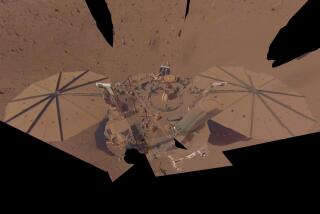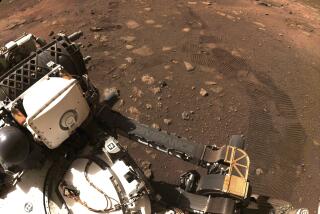Life on Mars? Newly discovered water is a strong sign, NASA says

Scientists scouring the Red Planet using NASA’s Mars Reconnaissance Orbiter say they have found direct chemical evidence of transient saltwater flowing on the surface.
It’s one of the most intriguing questions in science: Could life exist on Mars today?
On Monday came an answer: Yes, quite possibly.
Scientists using observations from NASA’s Mars Reconnaissance Orbiter said they’ve found powerful evidence that briny water routinely flows on the Martian surface.
This particular water source is so salty that it would probably be too harsh for life as we know it, scientists said. But the revelation, described in the journal Nature Geoscience, strengthens the potential for life on our rust-hued neighbor ‚ÄĒ not just during its wetter past but also its arid present, experts said.
‚ÄúIt suggests that it would be possible for there to be life today on Mars,‚ÄĚ said John Grunsfeld, associate administrator of NASA‚Äôs Science Mission Directorate in Washington.
Researchers haven’t spied the water directly. Instead, they detected hydrated salts in dark streaks that wax and wane in a pattern that serves as a smoking gun for liquid water.
‚ÄúThis is the first time we‚Äôve found flowing water on a planet that‚Äôs not ours,‚ÄĚ said study lead author Lujendra Ojha, a planetary scientist and doctoral candidate at the Georgia Institute of Technology.
Ashwin Vasavada, project scientist for the Mars rover Curiosity at NASA’s Jet Propulsion Laboratory, called the discovery exciting but not surprising.
‚ÄúWhat seemed really unbelievable 10 years ago ‚ÄĒ that Mars has modern, liquid water ‚ÄĒ has slowly become more and more an expectation,‚ÄĚ said Vasavada, who was not involved in the research. ‚ÄúAnd to have the evidence that that team found today is fantastic.‚ÄĚ
The atmosphere on Mars is cold and thin. That means pretty much any pure water on the surface would freeze or immediately evaporate, depending on the temperature. But if that water contained salts, it would be more stable in liquid form.
Scientists got their first tantalizing hint of the liquid in 2011 when a powerful camera aboard the Mars Reconnaissance Orbiter spied mysterious dark streaks that grow and fade with the seasons. The streaks seemed to be influenced by temperature, lengthening as the planet warmed in the late spring and summer, then shrinking in fall and winter.
They reappeared on Martian slopes each year, and scientists dubbed them ‚Äúrecurring slope lineae,‚ÄĚ or RSL. Geologists had a hunch that the streaks were caused by flows of water that were able to liquefy during the Red Planet‚Äôs warmer seasons. But they didn‚Äôt know for sure.
To see whether their hypothesis had any merit, they examined data from a key scientific instrument aboard the orbiter. The Compact Reconnaissance Imaging Spectrometer for Mars, or CRISM, can analyze the chemicals in a given spot on the surface by studying the telltale signature of dark bands in a sample of reflected sunlight.
But the RSL are tricky to study because most of them are too narrow for CRISM to see. So Ojha and his colleagues focused on four spots where the RSL were widest and discovered a strong fingerprint for hydrated salts.
In a lab on Earth, they conducted experiments to figure out which minerals were the closest match to the fingerprints from Mars. Magnesium perchlorate, magnesium chlorate and sodium perchlorate fit the bill.
All of these are salts with water locked into the mineral structure ‚ÄĒ a clear sign that briny water probably had flowed there.
‚ÄúIt‚Äôs incredibly exciting,‚ÄĚ said Bethany Ehlmann, a planetary geologist at Caltech who was not involved in the new research. ‚ÄúWhen we look back at the broad scope of Mars history, it‚Äôs always in the past where there‚Äôs evidence for the most water. But if there‚Äôs liquid water even today ‚Ķ that says that there was probably liquid water for all of the last 4.5 billion years, just like there was on Earth.‚ÄĚ
Where exactly the water comes from and how it’s released remain open questions, scientists said.
It’s possible that the briny flows could come from melted ice, but many of these spots are too close to the equator for water to stay frozen.
Another possibility is a phenomenon called deliquescence, in which the salts suck water molecules out of the air and hang on to them until there’s enough to form a very briny liquid.
Regardless of the source, researchers said the findings are sure to whet the appetite of astrobiologists looking to explore habitable environments on the Red Planet, both past and present.
‚ÄúTo me, the chances of there being life in the subsurface of Mars have always been very high,‚ÄĚ said study coauthor Alfred McEwen, director of the Planetary Image Research Laboratory at the University of Arizona and lead scientist for the Mars Reconnaissance Orbiter‚Äôs HiRISE camera.
Still, the water is so incredibly briny that it’s difficult to imagine microbes being able to survive with the harsh fluid.
‚ÄúIf I were a microbe on Mars, I would probably not live near one of these RSLs,‚ÄĚ Grunsfeld said. ‚ÄúI would want to live probably further north or south, higher latitudes, under the surface ‚ÄĒ quite far under the surface ‚ÄĒ and where there‚Äôs more of a freshwater glacier.‚ÄĚ
For the moment, the idea that such a location exists is speculative, although there is some evidence to support the idea, Grunsfeld said.
Scientists may learn more when NASA’s InSight spacecraft arrives on Mars in September 2016. It is due to land about 190 miles north of Curiosity to examine the temperature beneath the surface and learn more about the planet’s interior structure. That could help define how habitable the subsurface really is.
In the meantime, Curiosity may help fill in some details by monitoring streaks on Mt. Sharp, the peak that the rover is studying in the middle of Gale Crater. The streaks may not be RSL; they’re small and faint, and they don’t reappear with the clockwork regularity of the ones spied by the orbiter. They’re also on slopes too steep for the rover to traverse. But Curiosity may be able to study them from a safe distance, Vasavada said, taking higher-resolution and more frequent images than an orbiter could.
The new findings also give hope that there may be natural resources that future astronauts could mine when they get to Mars. Not only could the water potentially be harvested to drink and to provide oxygen to breathe, but the perchlorates also could in principle become an ingredient to make solid rocket fuel, Grunsfeld said.
‚ÄúAll of the scientific discoveries that we‚Äôre making on the surface of Mars ‚Ķ are giving us a much better view that Mars has resources that are useful to future travelers,‚ÄĚ Grunsfeld said.
Looking for signs of life on Mars? Follow me on Twitter @aminawrite and ‚Äúlike‚ÄĚ Los Angeles Times Science & Health on Facebook.
MORE FROM SCIENCE
Hajj disaster: Are large crowds inherently dangerous?
Dinosaur discovery in Alaska: A duck-billed herbivore that didn’t fear the snow
Rosetta’s comet is actually a partnership that’s lasted billions of years, study says







